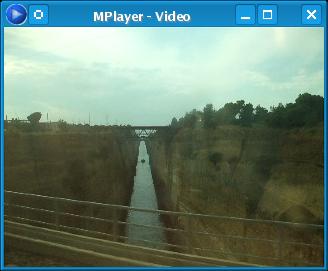
The Peloponnese — Corinth and Olympia
The Peloponnese
The Peloponnese or Peloponnesus is a large region of Greece, very nearly an island. It lies to the west and south of Athens, Patrai is near its northernmost tip in the map below. The Corinth Canal crosses the narrow isthmus that barely connects the Peloponnese to the European mainland. A few sites in the northwest near the isthmus could be visited on a long day trip out of Athens.
The canal is just 6.3 kilometers long, saving a potential 700 kilometer sea voyage around the Peloponnese. It was an obvious place for a canal and one was started in the 7th century BC, but it was only completed in 1893.
Corinth is a short bus or rail trip from Athens. The rail service is now provided with the Προαστίακος or Proastiakos suburban train. Wherever you are going in the Peloponnese, you have to pass through Corinth. Rail service is even more limited in the Peloponnese than it is in the rest of mainland Greece. You can continue by rail along the northern coast through Patrai to Pírgos and change there to an even smaller train to Olympia. And, you can go south by train past Mycenae to Argos and Nafplio.
See the dedicated pages for more details about bus and train travel within Greece.
Corinth / Κόρινθος
You could visit Corinth on a long day trip out of Athens. The train runs along the cliff faces above the Saronic Gulf on the way between Athens and Corinth. The view below is what you see from that train as it runs along the cliff. This is looking back toward Corinth just before sunset while returning to Athens from a day trip.
There are plenty of places to stay overnight in Corinth. I have stayed at the Akti Hotel, it's not too far from the old train station and the waterfront.
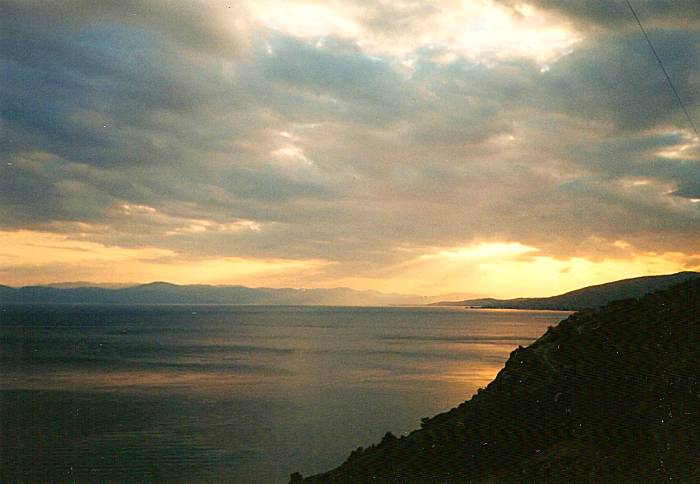
View of the Saronic Gulf from the Athens-Corinth train.
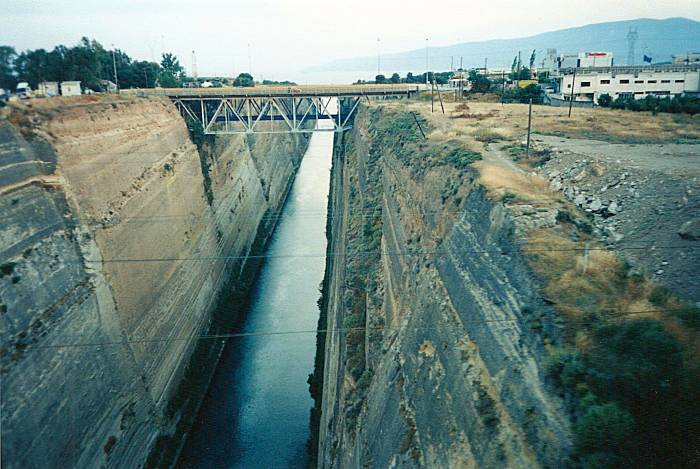
You cross the Corinth Canal just before you arrive in Corinth. The canal is at the town of Isthmus, which is where we get the word for a narrow strip of land connecting two larger land masses.
The canal was started under Periander in the 7th century BC, but it wasn't finished until 1881-1893. It's just 6.3 km long, but it saves a 700 km journey around the Peloponnesus! That is, if your vessel can fit into a 21-meter-wide canal...
The rock walls rise 90 meters above the water level. The deep and narrow channel funnels strong winds down it, making navigation difficult.
Also, there are small tides within the Mediterranean. They're so small that they generally don't matter, except in a situation like this canal. Strong tidal currents run along the canal at times, making navigation even more difficult. The largest ships that can fit through the canal have to be towed through it by tugs.
The Proastiakos suburban train moves quickly across the new bridge on its runs between Athens and Corinth. So, how can you get a picture?
Record a
video
and extract the sequence of frames with the free
mplayer
program:
% mplayer -vo jpeg dscf2292.avi
This aeronautical chart shows how narrow the isthmus is.
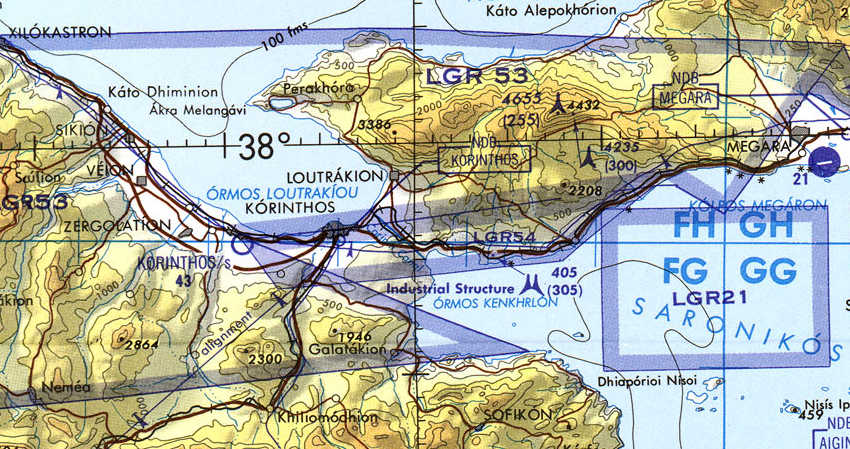
Despite all the dreaming for the design and the work to dig and maintain and repair it, the canal has never been very useful. It was initially thought that about 4 million net tons of shipping would pass through the canal every year, but in 1906, thirteen years after its opening in 1893, the total was only a half a million net tons per year. This rose to 1.5 million net tons annually by 1913, but then the First World War greatly reduced traffic.
The canal has always had trouble with the instability of its steep limestone walls. They're heavily faulted and are in an active seismic area, and so the canal has been closed for up to two years at a time by landslips.
If that wasn't bad enough, the Germans instituted a "scorched earth" approach to their retreat from Greece in which they used explosives to cause landslips, destroyed the bridges and dropped their wreckage into the canal, and followed that with locomotives and other destroyed infrastructure debris. It took the U.S. Army Corps of Engineers about a year to clean out that mess and re-open the canal to traffic.
Now the canal traffic is mostly limited to pleasure craft and tourist boats.
We're looking down the platform at the old train station. The Athens Προαστιακος or Proastiakos, the suburban commuter train, has been extended as far as Corinth. This is part of the slow process of extending standard-gauge rail lines across the northern shore of the Peloponnese. Corinth's main station is now at the edge of the city, and the old station seen here is no longer used.
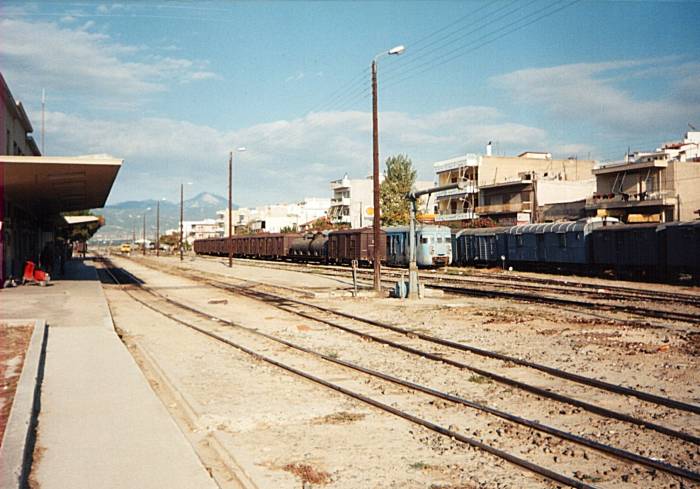
In Corinth, walk from the waterfront to the park in the center of town. Buses leave frequently from there to go to the ancient city of Corinth.
The site of the ancient city of Corinth seems to have been occupied at least since 6500 BC, if not earlier. The modern city was still there until a devastating earthquake in 1858 completely destroyed the city. Nea Korinthos or New Corinth was founded that year, much closer to the shore of the Gulf of Corinth.
Then New Corinth was largely destroyed by an earthquake in 1928 and an enormous fire in 1933. It was rebuilt after each, and it had the fastest growing population in the country during the 1980s.
It appears that there probably was a Mycenaean palace-city here, similar to those at Mycenae and Tiryns. Corinthian forces are said to joined Agamemnon's forces in the Trojan War.
Corinth became a unified state during the period 747-650 BC, with large-scale public buildings being constructed and Corinth establishing a colony at Corcyra, on Corfu, and Syracuse, in Sicily.
Κύψελος or Kypselos became the first tyrant of Corinth. Back then tyrants weren't so bad, it was simply a term for an absolute sovegeign ruler and did not imply an unrestrained or cruel rule.
Anyway, Kypselos had received a typically vague prophecy from the Oracle of Delphi which he interpreted to mean that he should take control of Corinth. He did, removing the existing Bacchiadae aristocracy and ruling over the city from 658 to 628 BC.
According to Herodotus, the Bacchiadae had received Delphic prophecies of their own that "the son of Eëtion" (that being Kypselos) would overthrown them. They sent two assassins to kill the newborn baby, but he had smiled at each assassin and they refused to carry out their mission. Years later he fulfilled the prophecies, overthrowing the Bacchiadae and taking control of Corinth.
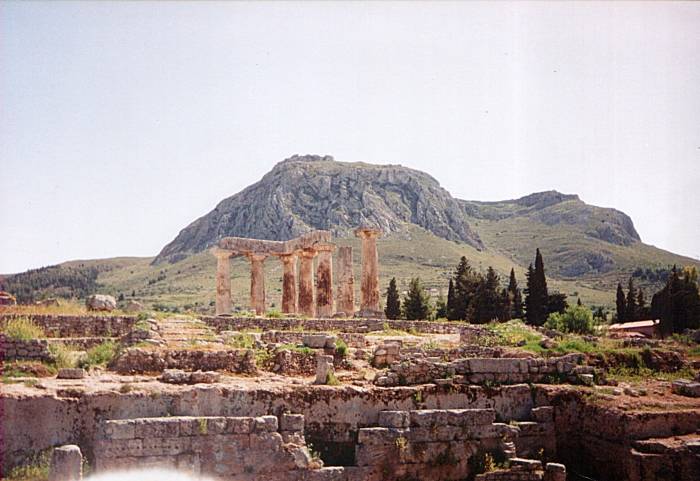
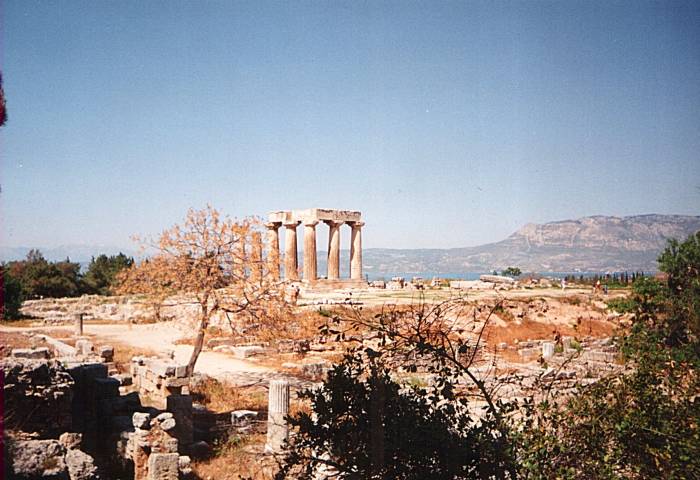
Kypselos built the Temple of Apollo seen here and a Temple of Poseidon in 650 BC. Under Kypselos and his son Periander, Corinth established many more colonies. Some of them were up the Adriatic coast into today's Albania, another was as far away as Egypt.
Periander was the one who tried to dig a canal through the Isthmus. He didn't manage that, but he did build the Δίολκος or Diolkos, a six-kilometer paved stone trackway along which boats could be dragged overland between the Ionian Sea and the Aegean Sea. It was paved with hard limestone, with parallel grooves about 1.60 meters apart in a roadway 3.4 to 6 meters wide. The grooves indicate that some sort of wheeled transport. It remained in operation over 600 years, until the middle of the first century AD and possibly longer.
This was the golden age of Corinth, during the reign of Kyselos, his son Periander, and Periander's nephew Psammetichus. The good times ended when Psammetichus was assassinated in 581 BC.
Corinth went on to prosper through classical times. The trade across the Isthmus gave it wealth rivaling Athens and Thebes. It had two harbors on either side of the Isthmus, one on the Saronic Gulf and the Aegean Sea, and the other on the Corinthian Gulf and the Ionian Sea. It also controlled the trackway connecting the two.
The city's sculptors developed the Corinthian order of classical architecture, far more complicated than the earlier and simpler Ionic and Doric models. The usual interpretation is that Doric is the simplest as it reflects a stricter and simpler lifestyle like that of the Spartans, Ionic is sort of a middle ground, and the complexity of the Corinthian style reflects the wealth and luxury of its home city.
Horace said "Non licet omnibus adire Corinthum", meaning "Not everyone is able to travel to Corinth", because of the expense.
The city was also influential in the geopolitics of the day, hosting the Conference at the Isthmus of Corinth at which the Hellenic League was organized to fight the Persian invasion.
Then the Persians were repelled and things got messy and confusing.
The Peloponnesian War saw Corinth going to war against Corcyra in 435 BC, with Athens coming in on Corcyra's side two years later. There had been military transport ships in earlier wars, but this was the first recorded naval war, with ship-borne forces fighting each order.
The Peloponnesian War ended in 404 BC, and then just nine years later the Corinthian war started and lasted from 395 to 387 BC. This one had Corinth and Thebes allied against Sparta.
Then, in 379, Corinth joined Sparta in an attempt to first defeat Thebes and then take control of Athens.
By 338 BC Phillip II of Macedon had defeated Athens and it allies. In that year he organized and led the League of Corinth to unite the Greek forces in yet another war against Persia.
Six years later in 332 his son Alexander the Great controlled Greece. Through the rest of the Hellenistic era, until the coming of Roman power, Corinth was like a lot of Greek cities. It was fought over and had little to no influence of its own.
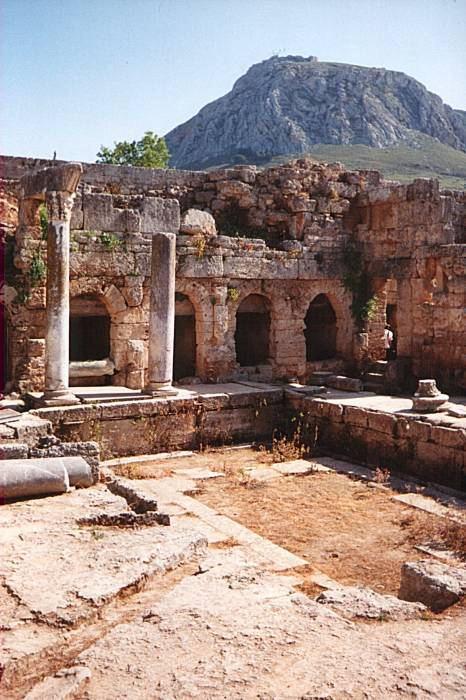
Check ferry schedules and buy tickets:
Rome declared war on the Achaean League in 146 BC. Roman forces commanded by Lucius Mummius beseiged Corinth. When they entered the city he had his forces kill all the men, sell the women and children into slavery, and burn the city.
The city was mostly deserted until Julius Caesar refounded it as Colonia Iaus Iulia Corinthiensis in 44 BC, immediately before being assassinated. Despite the sudden lack of his personal supervision, the city was rebuilt and flourished. It had a large population of Greeks, Romans and Jews.
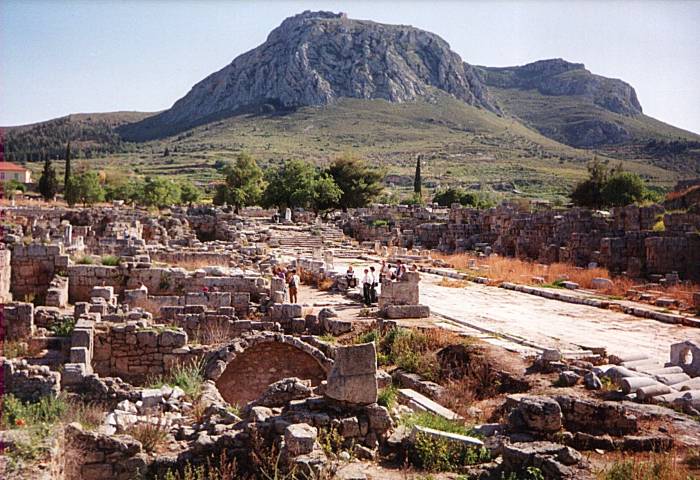
The apostle Paul visited here numerous times, and two of his letters to the Christian community there made it into the canon of the Christian New Testament.
Some scholars believe he wrote one or possibly two other letters, but if so they have been lost. There is an pseudepigraphal (that is, not accepted as officially canonical) Acts of Paul which contains an Epistle of the Corinthians to Paul and a Third Epistle to the Corinthians. This book seems to have been written by a later admirer of Paul who based it on oral traditions of his missionary work. It was once treated as canonical by the Syriac Orthodox Church and by the Armenians.
Ακροκόρινθος or Akrokorinthos, "Upper Corinth", was on the rocky mount looming over the city. It was said to have a Temple of Aphrodite with over a thousand temple prostitutes, at least according to Strabo's description. That is now thought to be an exaggeration.
I am reminded of a girl who lived in my dorm at Purdue. She made it very clear that she would only date guys in the ROTC program or otherwise committed to military service. She saw herself as a reward for their service, offered in advance. Had there been a Temple of Ares in West Lafayette in those days, I'm pretty sure she would have been one of its sacred prostitutes. Last I heard, she was a flight attendant for Delta Airlines.
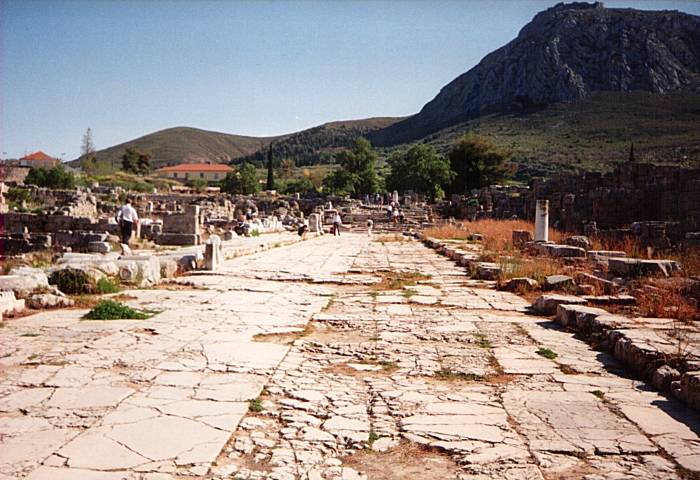

The city of Corinth was destroyed by an earthquake in 375. Then just 20 to 25 years later, the Visigoth Aleric I plundered the city and sold much of its population into slavery. Then another devastating earthquake hit in 551.
Let's hike up to Akrokorinthos, and see what's on top!
Acrocorinth was occupied from archaic times until the early 1800s. Its terrain makes it relatively easy to defend. Later Byzantines fortified it further.
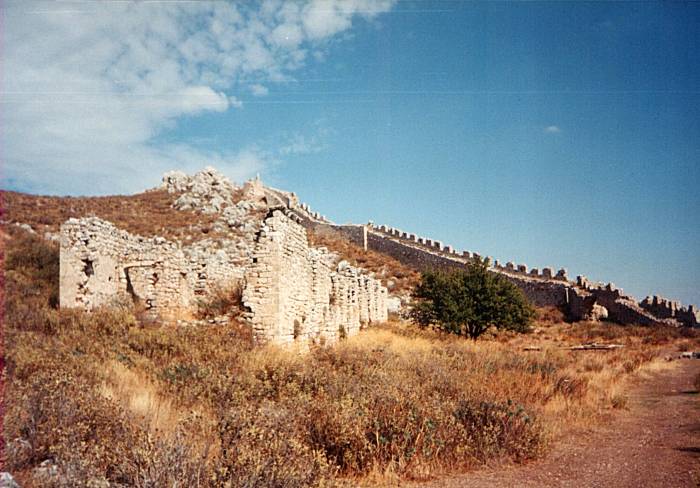

The main defenses form three concentric ring walls.
The western Crusaders captured Constantinople in the autumn of 1204, and then marched into Thessaly and turned south. The Acrocorinth citadel included the Upper Pirene Spring. This source of water allowed the citadel to hold out through five years of seige by the Crusaders until it finally fell in 1210.
The citadel had been seized by the Franks, becoming part of the Frankish Principality of Achaea. Later it came under the control of the Venetians, and after that, the Ottomans. There were three concentric rings of walls. The site of the former Temple of Aphrodite at the peak was converted first to a church, and then to a mosque.
The view from the top of Akrokorinthos is spectacular! The first picture here shows the view to the northwest, over the Gulf of Corinth and generally toward Delphi.
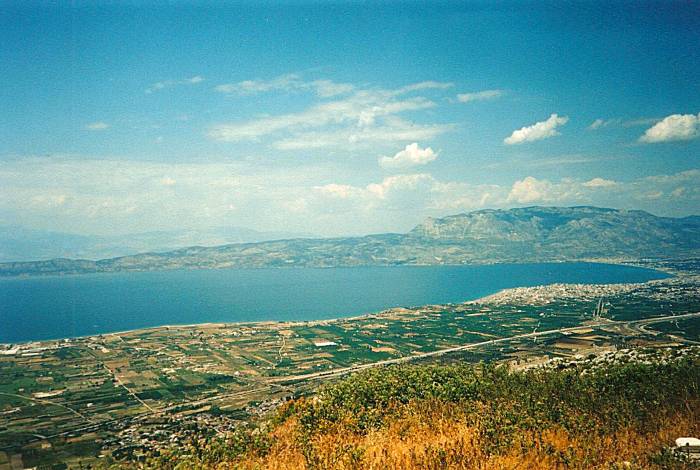

The second picture above shows the view to the northeast, across the Isthmus and over the Saronic Gulf toward Athens.
The port of Piraeus would be just a little further up the coast that we see in the distance toward the right.
At right we're looking to the northeast, into mainland Greece and beyond that to far eastern Europe.
This is the direction from which invading armies would have approached. The Germans, most recently. Five centuries before them, the Ottomans in the 1400s. Another millennium back, the Visigoths around 400 AD. A little over seven centuries further back, Alexander's army, and before him, the Persians. And don't forget the Athenians and other factions in the many wars between Greek city-states.
Olympia / Ολυμπία
I took a train from Corinth through Patrai to Pírgos, where you changed to an even smaller narrow-gauge train for Olympia.
You had to be careful buying your ticket, as you're going to Olympia on the Peloponnesus, and not Mount Olympus well north of Athens near Thessaloniki!
Of course, that was back in the day when Greece operated passenger trains. The last I read, trains didn't run past Corinth and you had to take buses the rest of the way from there.
The last link from Pírgos to Olympia stopped at some rather small stations like this one. This is the station at Πλάτανοσ or Plátanos, which you can see due east of Pírgos on the map. Olimpia was the next and final stop, just two kilometers past Plátanos at the end of that rail line near the river. The train station is about 300 meters east of the town center.
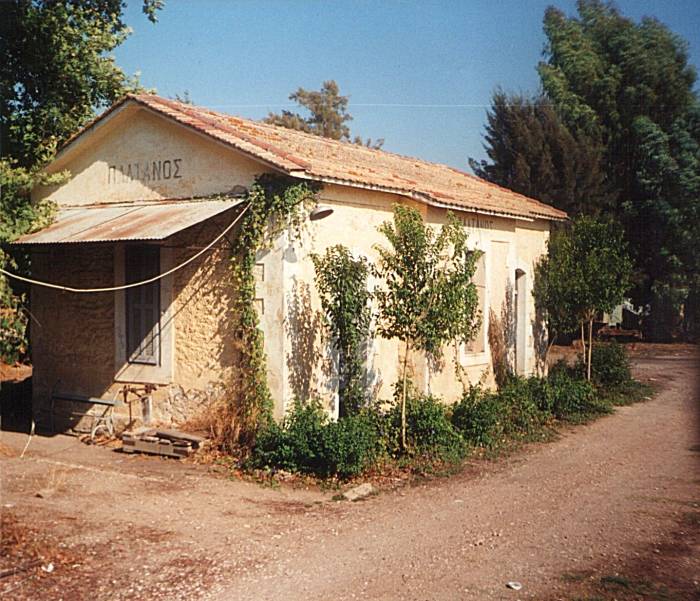
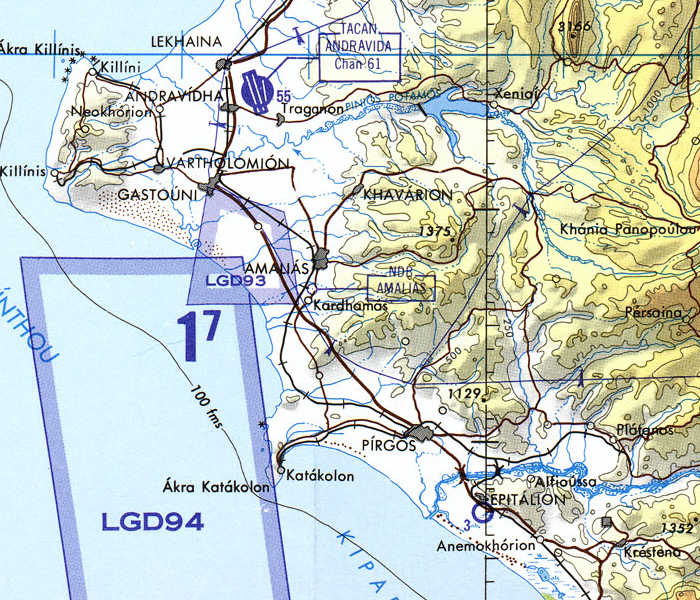
Here you can see the main stadium. This was the site of the athletic contests back in the day, the "Olympic Games" as they were called. This was before today's corporate sponsorships, and even before East German steroid-fueled domination.
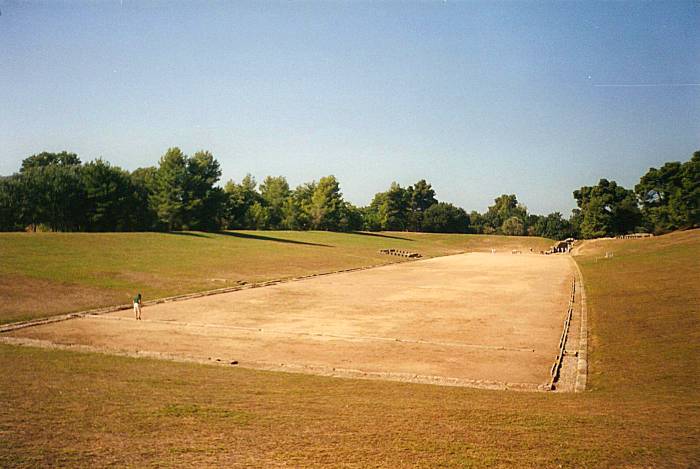
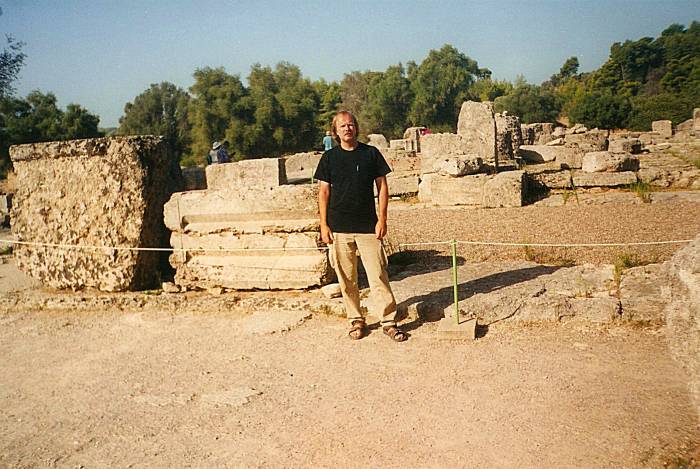
The games were held every four years in honor of Zeus, as the site was the location of the Temple of Olympian Zeus, built in 472-456 BC. The temple housed a statue which was one of the Seven Wonders of the Ancient World.
Like all of the ancient Seven Wonders except the Giza complex of the Pyramids and the Sphinx, it's all just ruins today. For other Seven Wonders pictures, see my pictures from Rhodes and the Temple of Artemis at Ephesus.
The sanctuary had been a religious site back to the 10th century BC, based on food and burnt offerings discovered there. The first Olympic festival was organized in the 8th century BC, tradition says that the first games happened in 766 BC.
The statue was a seated figure about 13 meters tall. It was what's termed a chryselephantine sculpture, made of plated ivory and gold panels on a wooden framework. No copy was made, we just have descriptions and a few limited depictions on coins.
One story is that the Roman Emperor Caligula gave orders that the most impressive statues from across the Empire should be brought to Rome, so their heads could be replaced with sculptures of his own and the results displayed in the imperial capital.
Another version is that it was taken to Constantinople only to be destroyed there in a fire in 475 AD.
Yet another version is that it was still in Olympia in 425-426. The Byzantine Emperor Theodosius II ordered that the sanctuary be destroyed as it was associated with a non-Christian religion. The Temple of Olympian Zeus and the rest of the complex was burned to the ground, destroying the statue if it was still there. Earthquakes in 522 and 551 destroyed what little survived.
The entire sanctuary was buried by landslides and silt deposited by flooding, so that its site was lost under up to eight meters of deposits. Mollusc shells and foraminifera in the deposits indicate that the flooding and burial was caused by tsunamis washing up the river valley from the sea. The site was rediscovered in 1766, and French historians partly excavated the Temple of Olympian Zeus in 1829.

